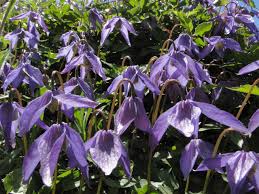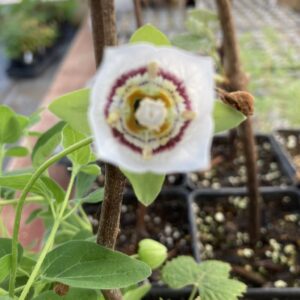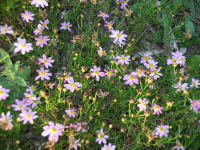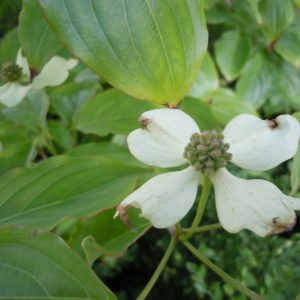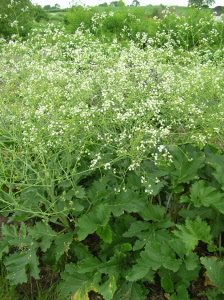Archives
Showing 41–48 of 164 results
-
Clematis columbiana v. tenuiloba syn. C. alpina v. occidentalis sub. var. tenuiloba Rock clematis Z 3-8
Deep violet elongated bells in early summer on short erect stems, only 6” high
ARCHIVED
Note: This is a plant not currently for sale. This is an archive page preserved for informational use.
Deep violet elongated bells in early summer on short erect stems, only 6” high
Size: 6" x 12"
Care: sun to part shade in moist well-drained soil
Native: Rocky Mountains & the Dakotas1st described in 1881 by Harvard botanist Asa Gray
-
Clematis recta ‘Purpurea’ Ground clematis, Flammula clematis POISONOUS Z 3-9
Fragrant star-shaped white blooms May-July on attractive purple foliage, fading to green by mid-summer.
ARCHIVED
Note: This is a plant not currently for sale. This is an archive page preserved for informational use.
Fragrant star-shaped white blooms May-July on attractive purple foliage, fading to green by mid-summer. Can be trained to climb or left as a groundcover. Handling plant may cause contact dermatitis or allergic reaction
Size: 3-5' x 2-4'
Care: sun to part shade with moist well-drained soil. Pinch back buds to maintain purple foliage longer-when plant blooms foliage fades to green.
Native: Eastern, southern and central Europe.
Wildlife Value: attracts hummingbirds, butterflies & bees; Deer and Black Walnut tolerantRecommended for its purple foliage in The Gardens of Gertrude Jekyll.
-
Codonopsis ovata syn. Glosocomia ovata syn. Wahlenbergia roylei Kashmir Bellflower, Bonnet Bellflower Z 3-7
Large, single, pendulous, milky-blue bell-shaped flowers flared at the tips. Blooms July-August.
ARCHIVED
Note: This is a plant not currently for sale. This is an archive page preserved for informational use.
Large, single, pendulous, milky-blue bell-shaped flowers flared at the tips. Blooms July-August.
Size: 15” x 15”
Care: sun to part shade in moist well-drained soil
Native: Himalayas, from Pakistan to Kashmir
Wildlife Value: attracts Bees
Size: Root is edible (but not tasty) when cooked. It can also be dried and ground into a powder. A famine food, used when all else fails. The roots and leaves have been used in its native areas to make a poultice for the treatment of bruises, ulcers and wounds. Medicinal use published 1895.Collected before 1835.
-
Coreopsis rosea Pink tickseed Z 4-8
Dainty (appearing but actually tough) pink daisies with yellow centers from summer through autumn, very long blooming. Wonderful for rock gardens, groundcover or front of border.
ARCHIVED
Note: This is a plant not currently for sale. This is an archive page preserved for informational use.
Dainty (appearing but actually tough) pink daisies with yellow centers from summer through autumn, very long blooming. Wonderful for rock gardens, groundcover or front of border.
Size: 12” x 12” spreading
Care: full sun in well-drained soil. Slow to emerge in spring.
Native: Eastern No. AmericaCoreopsis is Greek meaning “buglike” referring to the seeds looking like little black bugs. Thomas Nuttall 1st collected this flower in 1815 about 20 miles NW of Savannah along the river. He described its native habitat: “in open grassy swamps from New Jersey to Georgia…” William Robinson, father of the mixed perennial border called this “a neat and pretty plant.” In 1913 Sanders wrote that it “make(s) a brilliant display of color (when) grown in masses in sunny borders.”
-
Cornus kousa Kousa dogwood Z 5-8
Audacious, snow white 4” bracts for 4-6 weeks in June & July cover shrub’s horizontal branches, followed by crimson fruit in late summer & scarlet foliage in fall.
ARCHIVED
Note: This is a plant not currently for sale. This is an archive page preserved for informational use.
Audacious, snow white 4” bracts for 4-6 weeks in June & July cover shrub’s horizontal branches, followed by crimson fruit in late summer & scarlet foliage in fall.
Considered an invasive/illegal species in Maryland
Size: 15’ x 15’
Care: sun to part shade in well-drained soil Prune: little required, done in late winter
Native: Asia
Awards: Cary Award Distinctive Plants for New EnglandCalled Yamaboushi in its native Japan. In 1861 George Rogers Hall, residing in Yokohama, sent the 1st Cornus kousa seed to America from Japan. Francis Parkman sowed the seeds in his garden in Jamaica Plain MA garden. By the 1890’s 2 nurseries sold it in the U.S. – Parsons & Sons Co. and Yokohama Nursery. “Chinese” Wilson introduced the variety var. chinensis from Hupei Province in central China in 1907.
-
Cottage Garden for sun
Cottage Garden for sun
ARCHIVED
Note: This collection is not currently for sale. This is an archive page preserved for informational use.
Cottage Garden for Sun Size: Height x Width* Bloom color
Spring blooming
1 Anemone sylvestris – Windflower 12” x 12” spreading white
1 Papaver orientale – Poppy 2-3’ x 2’ orange
Summer blooming
1 Alcea rosea – Hollyhock (reseeding biennial) 2-3’ x 2’ varies
3 Delphinium exaltatum – Tall larkspur 3-4′ x 9″ purple
3 Lilium lancifolium – Tiger lily 3-4’ x 12” orange
3 Phlox paniculata – Garden phlox 4’ x 2’ magenta
1 Stachys byzantia – Lambs ear 12”x 12” lavender-pink
Fall blooming
1 Aster novae angliae – New England aster 3-4’ x 24” pink or purple
1 Boltonia asteroides – Bolton’s aster 5-6’ x 3’ white
3 Eupatorium coelestinum Blue mist 3’ x 2-3’ blue18 plants for $174.67. Would be $205.50 if purchased separately. You save $30.83.
If planted together in one garden these make a 33 square foot garden.
*Most of these plants get wider by spreading roots or by self-seeding over time.
All plants are perennials except the Hollyhock which is a biennial that reseeds.
If you plan on coming to the Nursery to purchase this collection, please give us at least 24 hours notice to prepare the collection for you. -
Crambe cordifolia Colewort Z. 5-9
Giant profusion of white flowers from late May to June
ARCHIVED
Note: This is a plant not currently for sale. This is an archive page preserved for informational use.
Giant profusion of white flowers from late May to June
Size: 7-8’ x 5’
Care: full sun in well-drained soil
Native: CaucasusFirst collected before 1863. ”This is a stately and noble plant, with large heart shaped leaves. The loose flower-heads, which are often 6 feet in height, and nearly as much through, are composed of myriads of small white flowers, which at a distance may be likened to a giant specimen of Gypsophila; it blooms during June and July.” H.H. Thomas 1915.
-
Cryptotaenia japonica ‘Atropurpurea’ Purple-leaved Japanese Wild Parsley, Japanese honeywort Z 4-7
Flowers light pink small umbels in mid-summer but forget the flowers and grow this for its showy purple bronze stems and leaves, branched stems with deeply divided, compound leaves and slightly ruffled
ARCHIVED
Note: This is a plant not currently for sale. This is an archive page preserved for informational use.
Flowers light pink small umbels in mid-summer but forget the flowers and grow this for its showy purple bronze stems and leaves, branched stems with deeply divided, compound leaves and slightly ruffled edges
Size: 18-24" x 8" and self-seeds to make clumps
Care: sun to part shade in moist to moist well-drained soil
Native: eastern Asia1st described in Journal of Japanese Botany in 1926. Asians use Honeywort as a seasoning, a strengthening tonic and eat its sprouts in salads but toxic if eaten in large quantities.
CAUTION: may cause dermatitis with repeated contact in some people; toxic if eaten in large quantities.

